
Noorani Qaida is a basic tutorial book that helps in teaching the basics of the Arabic alphabet and Quranic grammar. It provides a progressive approach to learning from basic letters to complete words and then the verses. Noorani Qaida Lesson 1 of the Noorani Qaida course will help you read and pronounce Arabic words efficiently in less time.
Noorani Qaida Lesson 1- Separate Letters
In Noorani Qaida Lesson 1, we will take you to separate letters (Huroof e Mufridaat) in the Arabic language.
There are 29 separate letters in Arabic. These letters have specific pronunciations and characteristics. It should be kept in mind while pronouncing these letters that they should not be pronounced in Urdu style like… Alif, bey, tey…… rather, they are pronounced as alif baa taa saa……
Below we will study the Arabic alphabet with sound in detail.
Noorani Qaida Lesson 1 Class 1
In 1st class of noorani qaida lesson 1 you will learn lesson from alif baa taa(ا٬ب٬ت) to saad zuad (ص٬ض)
Noorani Qaida Lesson 1 Class 2
In 2nd class of noorani qaida lesson 1 you will learn lesson from tau zua (ط٬ظ) to Yaa (ي)
Arabic Alphabets With Pronunciation In English
In Noorani Qaida lesson 1, you will get to know about Arabic Alphabets With Pronunciation In English and learn them smoothly. This table will help you how to pronounce the Arabic alphabet.
This Arabic alphabet chart with pronunciation will assist you in learning them swiftly.

Arabic Vowels and Arabic Consonants
Now that we have learned how to pronounce the Arabic alphabet, we will learn Arabic Vowels and Arabic Consonants. Out of 29 Arabic alphabets, there are six vowels in Arabic language. There are three long vowels in Arabic language and three short vowels. The Arabi alphabets that give the sound of AAA, UUU, and EEE are the long vowels in Arabic.
Long Vowels in Arabic Language
The alphabets Alif (ا), Waw (و), and Yaa (ي) are the long vowels in Arabic language.
- Alif (ا) produces the sound of ‘AAA’
- Waw (و) produces the sound of ‘UUU’
- Yaa (ي) produces the sound of ‘EEE’
Arabic Short Vowels
There are three Arabic short vowels and they are called Harkat. They are represented by the specific marks placed above or below the consonant. They are termed as;
- Fatha is placed above the alphabet and pronounced as ‘a’
- Kasrah is placed beneath the alphabet and pronounced as ‘e’
- Dhamma is also placed above the alphabet but pronounced as ‘u’
This Arabic vowels chart will help you get them easily
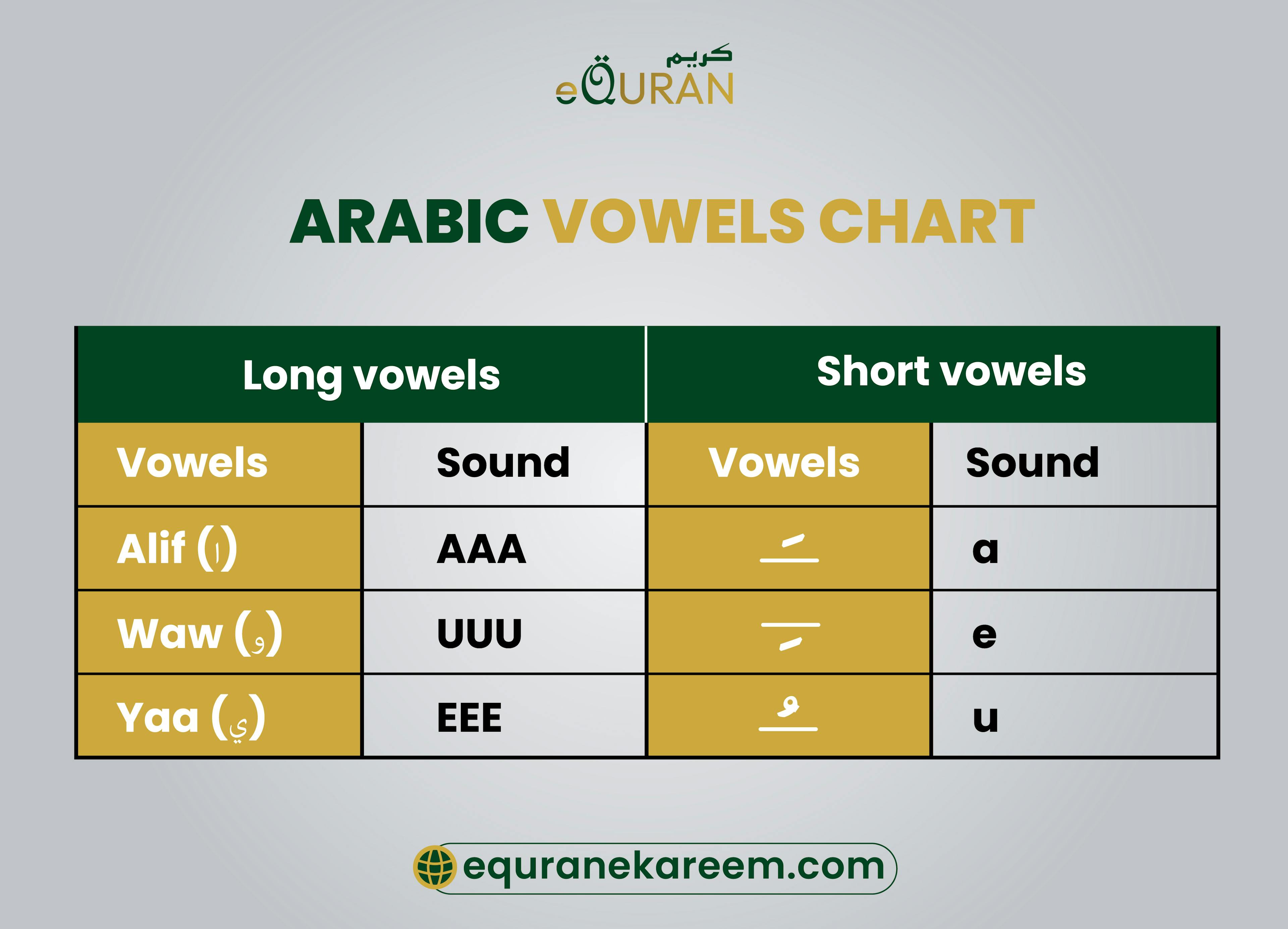
The Concept of Makharij in Arabic Language
Makharij in Arabic language refers to the articulation points in the vocal tract where Arabic letters are produced. The position from which the alphabet is pronounced is called ‘Makhraj’.In Noorani Qaida Lesson 1, we will make you understand makharij and teach you how to pronounce them. First, let's get some basic information about makharij.
There are 17 makharij (articulation points) produced from five main makjarij (articulation areas). The five main makharij are listed below.
- Al Halq - الحلق -(The throat )
- Al Lissaan -اللسان-(The tongue )
- Al Jawf - الجوف- ( The oral cavity )
- Ash-Shafatain-الشفتان -(The lips )
- Al Khayshoom- الخيشوم-(The nasal cavity )
Makharij Chart
The makharij chart will help you with understanding and easy memorization of Arabic makharij.
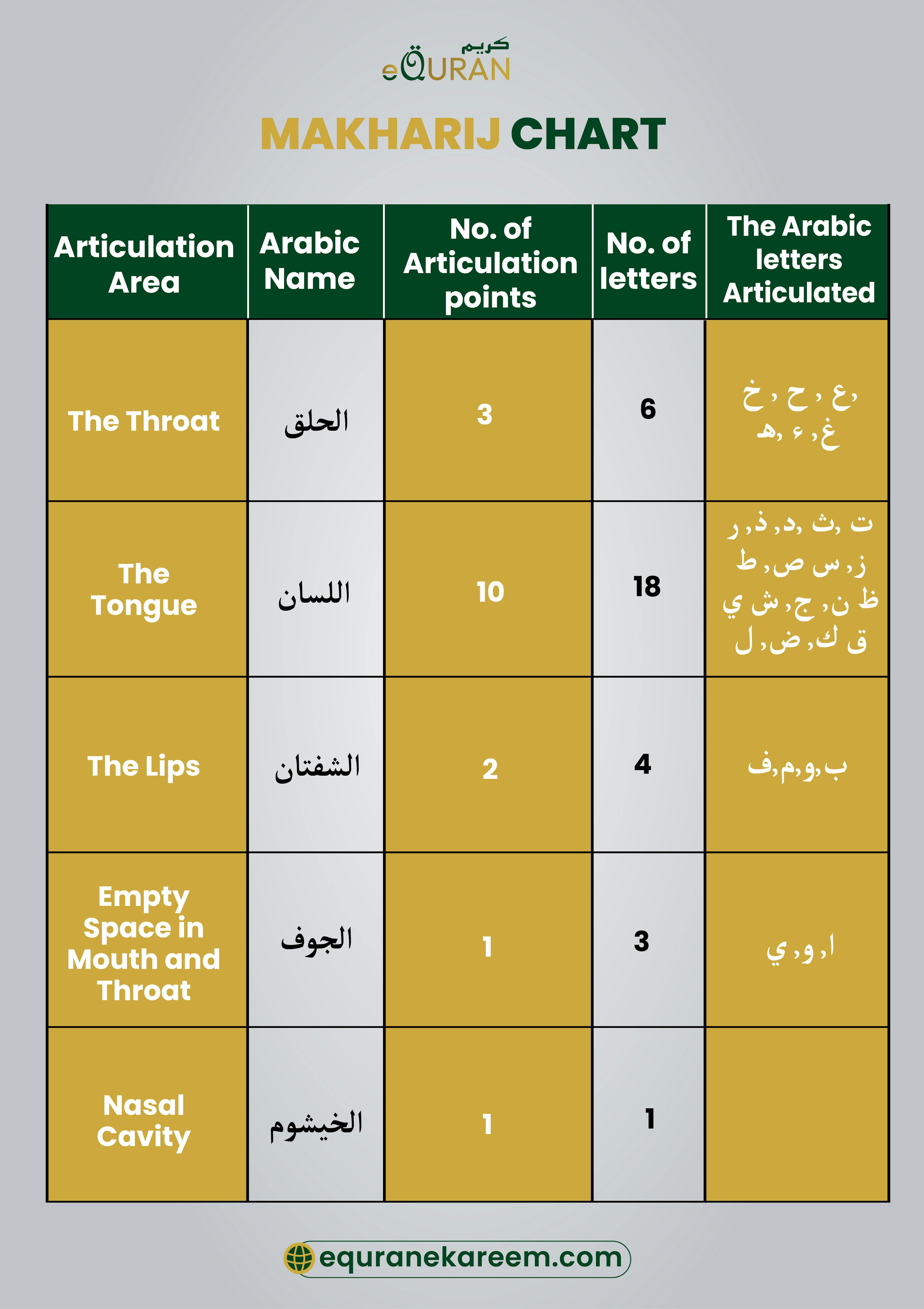
Until now we learned about the makharij and the positions they originated from. Now we will learn each category in detail.
Throatal Letters- Haroof e Halqi
Throatal Letters or Haroof e Halqi are the letters that originate from the throat. These letters are also known as letters of Qalqalah. Six letters originate from three different articulation points. From each articulation point (makhraj) two letters originate.
Let’s look deep into it.
Our throat has three main parts. The upper throat, the mid throat, and the deep throat. Two letters are produced from each part.
- The Upper Throat; two letters originate from the upper throat. These are
- Khaa ( خ ), pronounced as “kh”
- Gain ( غ ), pronounced as “gh”
While pronouncing these letters, it should be kept in mind to differentiate the upper throat from the inner mouth. Ga’in ( غ ) is articulated from the same makhraj but a little below from Khaa’ ( خ )
- The Mid-Throat; from the mid throat, two letters are articulated. These are
- Haa( ح ), pronounced as“hh“
- A’in ( ع ), pronounced as ‘a “
The tongue is moved back toward the throat wall while producing ( ح ), and ( ع ).
It is important to note that ( ح ) and ( هـ ) are not the same, and that ( ح )has a much sharper sound and is generated just above the( ع ).
- The Deep Throat
Haa’ (هـ), and Hamzah (ء), are articulated at the deepest part of the throat.
Closing the windpipe and opening it generates (ء), while (هـ) is produced by opening the windpipe and releasing the air. The tongue remains stable while producing both of these letters.
These six letters are known as Haroof e Halqi or Haroof Halki. It is important to master their pronunciation to learn the tajweed rules.

Arabic Letters and Words-The Tongue اللسان
The are 18 letters in the Arabic language( ت ,ث ,د, ذ, ر, ز, س ص, ط, ظ, ن, ج, ش ي ,ق, ك, ض, ل) that originate from 10 articulation points of the tongue.
These letters are further divided into specific makharij to help us understand which part of the tongue helps pronounce each letter. This will be covered in detail in the Norani Qaida course.
Before going to pronounce these letters we should know about articulation points of the tongue.. The four parts of the tongue are;
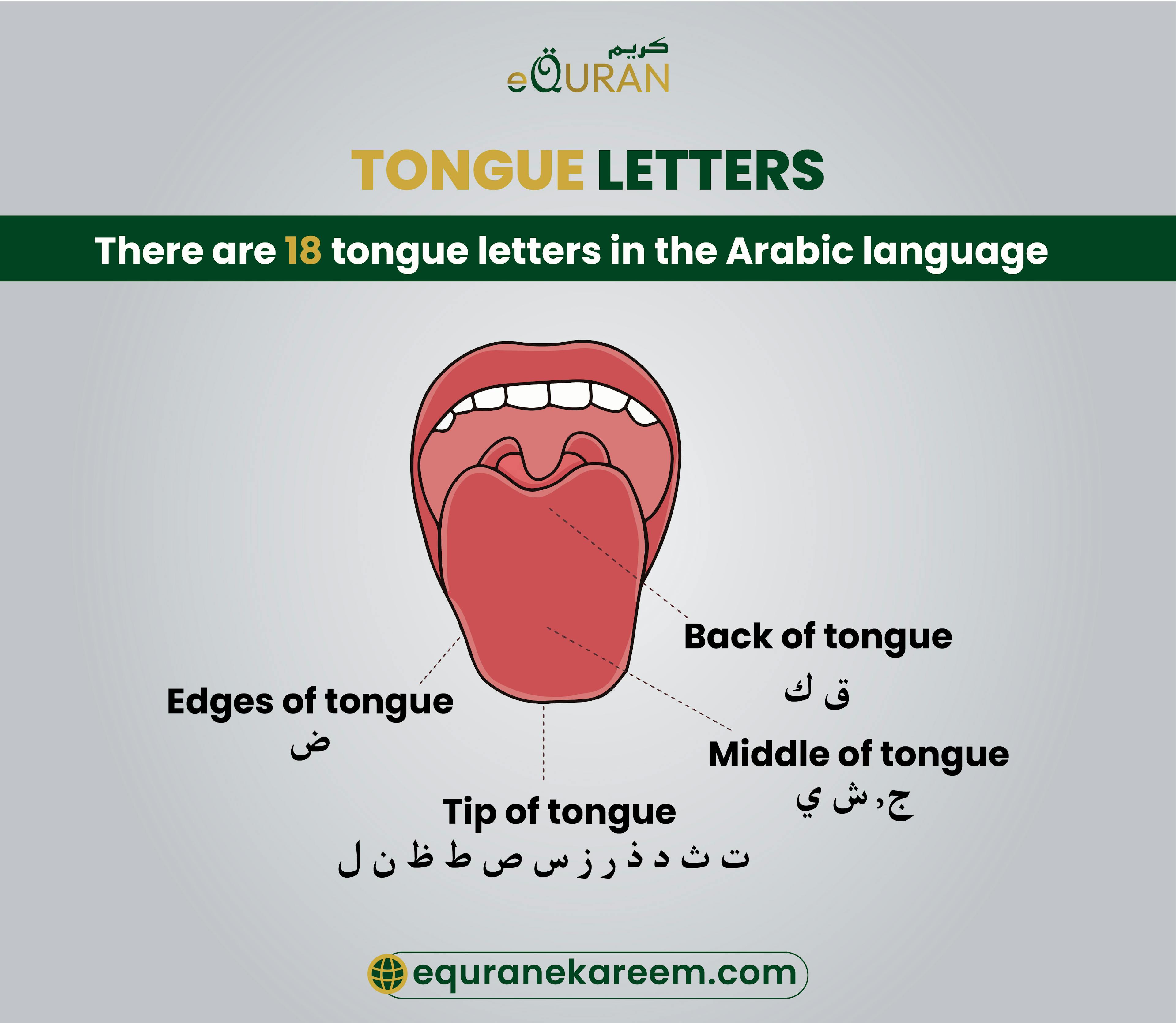
- Tip of the tongue
- Middle of the tongue
- Edge or side of tongue
- Back of the tongue
Arabic Letters and Words Pronounced From Tip of The Tongue
There are 12 Arabic letters and words that originate from the tip of the tongue. While pronouncing these 12 letters ( ت ث د ذ ر ز س ص ط ظ ن ل) the tongue touches the edge of the front two teeth or just behind them.
Let's study them in detail.
- Laam( ل ) is pronounced by touching the tip of the tongue with the gums premolars from one side.
- Noon (ن ) generated slightly behind the Laam by hitting the hard plate just above it.
- The makhraj of Raa(ر) is near and slightly behind the noon. While pronouncing it the sides of the tongue up to the tip will touch the gums of the molars.
- ت د ط is produced when the front tip of the tongue touches the gumline of the top front two teeth.
- The open area between the top and bottom teeth which generally produces a hissing sound. This area is makhrij of( ص س ز).
- When the front tip of the tongue touches the tip of top front teeth ث ظ ذ are produced. Pressing the tongue between two front teeth while passing out air produces(ث ذ) while elevating the tongue produces ( ظ)
Letters Pronounced From Middle of The Tongue
The middle tongue is the exit point for three letters( ج ش ي). These letters are produced when the middle part of the tongue meets the upper palate.
Letters Pronounced From Edge or Side of The Tongue
The side of the tongue is the makhraj of only one letter( ض). It is produced when the edges of the tongue touch the gums close to the upper molars. It is pronounced in two ways;
- When the left edge of the tongue touches the gums on the left side
- When the right side of the tongue touches the gums on right side
Letters Pronounced From The Back of the tongue
From the back side of the tongue, two letters ( ك ق) originate. Kaaf ك is produced by touching the roof of the tongue on the hard palate. Qaaf ق is generated by touching the roof of the tongue on the soft palate.
The lips -الشفتان
The lips have four makhraj (point of articulation). The letters ب,و,م,ف generated in the makhraj of the lips.
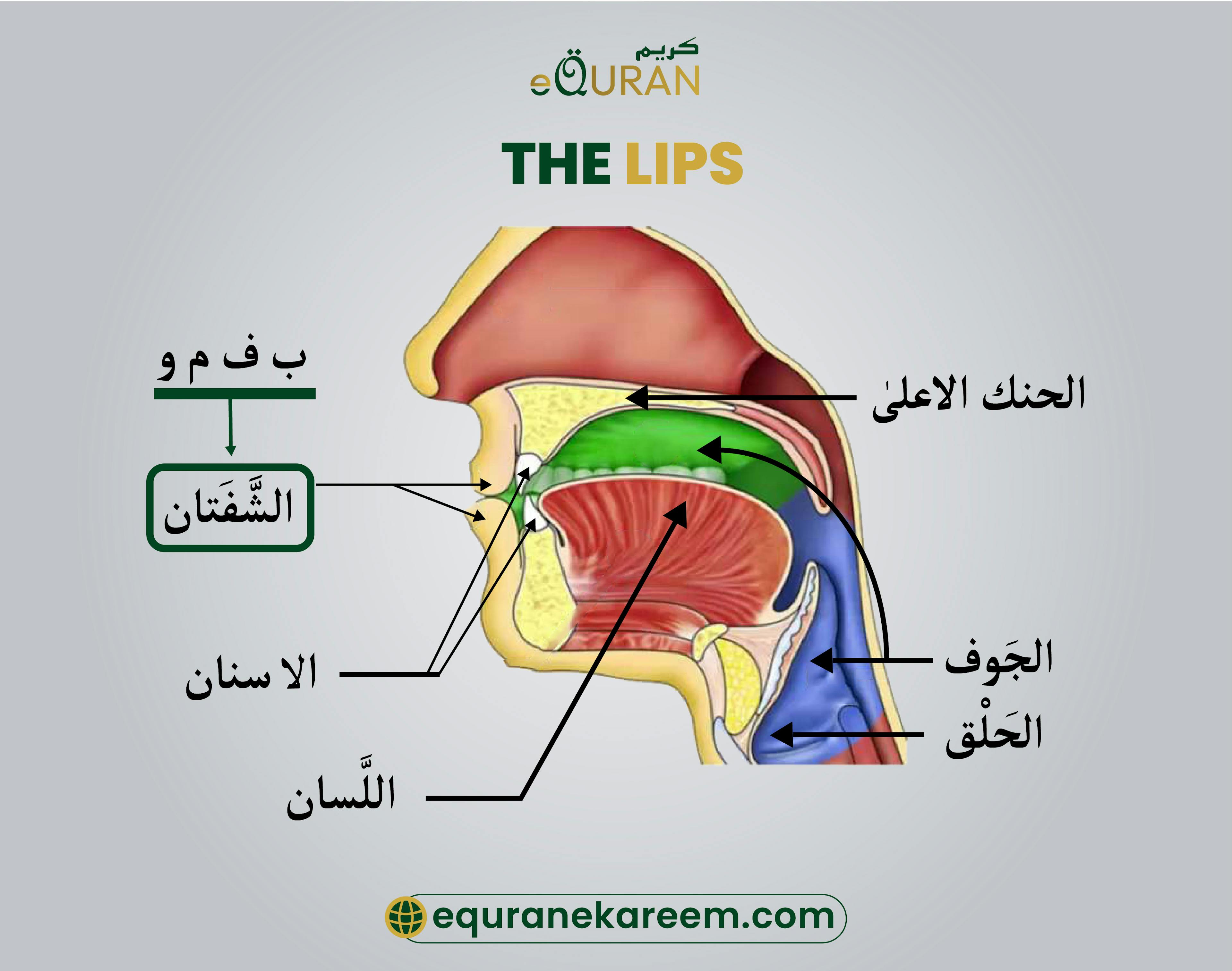
Between The Two Lips
- Baa ( ب ); By pressing two lips together and releasing them produces ( ب )
- Meem (م); Meem is produced by pressing two lips together and passing (ghunnah) through a nasal cavity
- Waaw( و); is produced by making a slight circle with both the lips without touching them completely.
The Bottom Lip and Upper Incisors
- Faa ( ف ); is produced by pressing the tips of the above teeth against the inner part of the bottom lip and exhaling through the mouth.
Al Jawf الجوف
Al Jawf, the empty space in the mouth and throat is the articulation point for three lengthened letters (ا, و, ي )
Like other letters, these three elongated (madd letters) don't have any specific space where they finish. Instead, Al-jawf letters end in the air when the sound stops. These letters with harkaat on them, pronounced aa oo ee Arabic alphabet.
- Alif ( ا ) preceded by fatha, pronounced “aa”
- Yaa ( ي ) preceded by kasra, pronounced “ee”
Waaw ( و ) preceded by dammah, pronounced “oo”
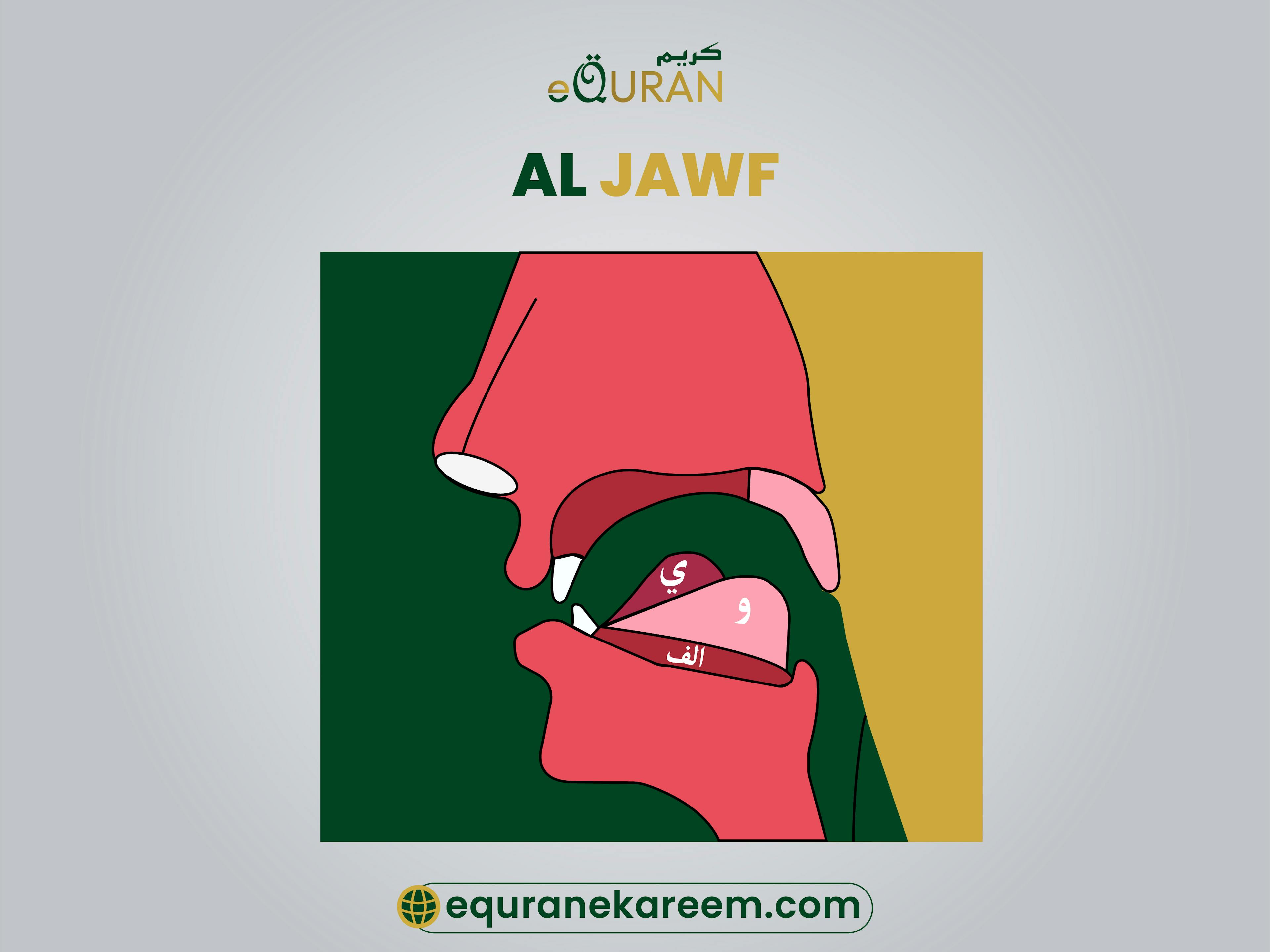
Nasal Cavity الخيشوم
The nasal cavity Al-khaishum is the last makhraj to be studied in Noorani Qaida Lesson 1 of the Noorani Qaida Course.
The nasal passage has only one point of articulation. Only ghunnah originated in this area of articulation. The tongue is not involved while producing ghunnah.
Keep in mind that a ghunnah is not a letter, but it is a characteristic of the letters noon( ن) and meem(م) if they have shaddah on them.

So far we studied makharij and basic letters. You can download Norani Qaida English PDF and learn it at ease of your comfort.
Arabic Word | Description | Arabic Letters in English |
ا,ع | ا Is a long vowel, pronounced softly ع pronounced strongly | Alif A’in |
ت ط | ت is pronounced with empty moth | Taa Tuaa |
ث,ص,س | ث is pronounced softly with empty mouth ص whistle sound-letter pronounced with full mouth س is also whistle letter pronounced with empty mouth | Saa Suaad seen |
ح,هـ | ح is pronounced abruptly هـ is released relaxly | Haa ha |
ك ,ق | ك is pronounced with empty mouth | Kaaf |
ك ,ق | ك is pronounced with empty mouth ,ق is pronounced with full mouth | Kaaf Quaaf |
ذ, ز | ذ soft word pronounced with empty mouth ز soft letter pronounced with full mouth. | Zaal zhuaal |
ظ, ض | ظ is a whistle word with an empty mouth. ض is pronounced with full mouth | Zaa zaad |
Conclusion
Qaida Noorani is the basic tutorial book to learn Arabic. It helps people especially kids and beginners to read the Quran correctly.
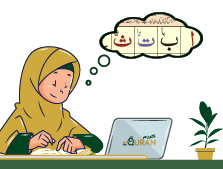
Learn Noorani Qaida Online
Now it is easy to learn Noorani Qaida Online, you can learn it proficiently while sitting at your home. The Online Noorani Qaida Course of eQuranekareem helps you to learn Norani Qaida progressively under experienced teachers.



